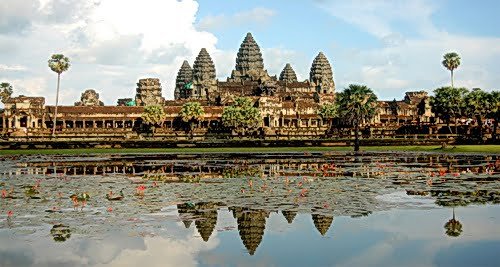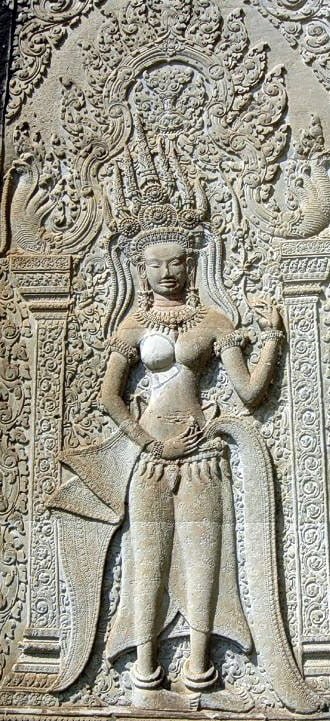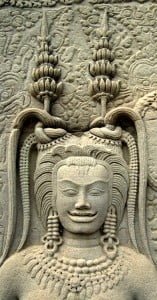About

In the 12th Century AD, the Khmer Empire ruled most of what is now Southeast Asia. As Europe struggled in the Dark Ages, King Suryavarman II built the massive edifice of Angkor Wat at the height of his empire’s glory.

But within 200 years, the powerful Khmer civilization mysteriously collapsed. Theories about the cause of its downfall abound but nothing is definite. You see, aside from limited temple inscriptions no written records of the great Khmer Empire survived its demise. The “best” written account available is from the Chinese diplomat Zhou Daguan, who recorded his journey to Suvannabhum — the legendary Khmer “Land of Gold” — 150 years after Angkor Wat was completed.
Centuries passed. Dense jungle swallowed the magnificent Khmer temples and cities. Western scholars had never even learned that the great Khmer race ever existed.
But in the 19th Century, French explorers rediscovered the ruins, initiating 150 years of intense scholarship that continues today. Yet we believe that they have missed the most important keys to the puzzle, hidden in plain sight…
People worldwide instantly recognize Angkor Wat.
Few, however, realize that this massive temple protects an extraordinary treasure unlike any building on Earth: Upon its walls we find a royal portrait gallery with 1,795 women realistically rendered in stone.
For 150 years, scholars have dismissed the women as “wives to entertain the king in heaven” or “ornaments to decorate bare sandstone walls.”
Our growing body of research indicates that these women served much more profound roles than mere decoration. And perhaps these women were the driving force behind the civilization itself.
To this day, no one knows the identity of a single woman at Angkor Wat.
About Devata.org
For the first time, researchers at Devata.org ask:
Who were the women of Angkor Wat?
Why are images of women immortalized with the most prominent placement in the largest temples the Khmer civilization ever built?
What did these women mean to the Khmer rulers, priests and people?
How does the Cambodian dance tradition relate to the women of Angkor Wat?
Do the women of Angkor Wat embody information important to us in modern times?

Devata.org is seeking answers to these questions in a variety of ways. This website is an information clearinghouse for all who wish to participate in this adventure. Here are some key areas of inquiry:
Articles: The drop down articles tab gives you quick access to all our categories.
Book News & Reviews: Articles about books and authors relating to Khmer history and our investigation.
Cambodian Dance: Since the dawn of recorded history, Khmer and Siamese royalty have nurtured a sacred female dance tradition passed down from teacher to teacher. Today’s dancers preserve a modern inheritance of discipline, grace and wisdom. Articles include historic photos of King Sisowath’s dancers, a modern troupe reviving sacred dance in Cambodia, an interview with Princess Buppha Devi of Cambodia and much more about Cambodian dance; ancient and modern.
Children of Angkor: Children literally born in the shadow of Cambodia’s most sacred sites continue the traditions of their ancestors by learning traditional arts of dance, music, crafts and design. Feature articles cover news about a new school of sacred dance near Banteay Srei, the healing properties of Cambodian dance, and more.
Devata Research: Here you’ll find article about our research including: the Angkor Wat Devata Inventory, the Devata Database Project, Facial Pattern Recognition work with Michigan State University, “Is Angkor Wat a 12th Century Facebook“, excepts from the upcoming book “Daughters of Angkor Wat”, and more.
Devata Temples: Meet the women of Angkor Wat (and other Khmer temples) face to face. Our website features a detailed list of devata goddess temples in Cambodia, Thailand, Laos and India. We’re also beginning to share the world’s first online photo galleries with sequential, mapped portraits of the women of Angkor Wat. Our digital archive has thousands of technical photos of women portrayed in the major Khmer temples, that will eventually be available to the public here.
Heritage Preservation: Devata.org supports many international groups working to preserve and perpetuate the ancient history, culture, art and literature of Southeast and South Asia.
Women’s History: Despite populating the world’s largest religious structure of Angkor Wat, the identities and importance of the women seen there have been forgotten and then ignored. Devata.org is working to recognize their significance. Likewise, women worldwide still seek equality and recognition for their contributions. For that reason we periodically present special articles about woman’s history dealing with issues beyond Southeast Asia.

Invitation to Participate: If the importance of women in history resonates with your beliefs we invite you to get involved. We need help in these vital areas: translation (French to English, English to Khmer), promoting online visibility of women in history (bloggers welcome), promoting this info in conventional media (newspapers, TV, radio) and contributing your own ideas, research and papers (including for potential publication).
In the meantime, please enjoy, question, debate and contribute to the theories and information offered on Devata.org.
Use your eyes, your heart and your mind. Weigh the evidence.
These ancient women have much to teach us about the rich history of Asia. They embody a variety of cultures stretching from India through Southeast Asia and Indonesia to China.
Join us in celebrating the contributions of the Khmer Civilization: past, present and future.
With best regards,
Kent Davis [kentdavis @ gmail.com]
Project Coordinator
